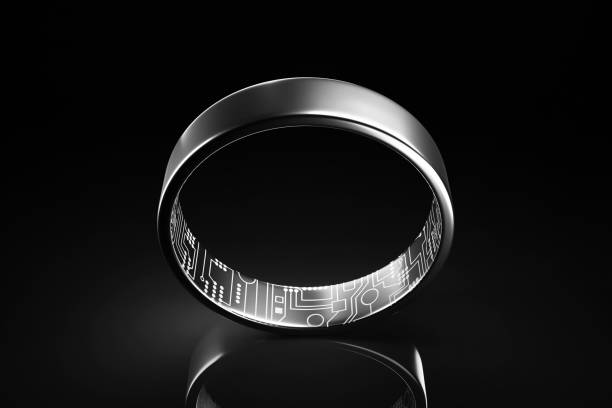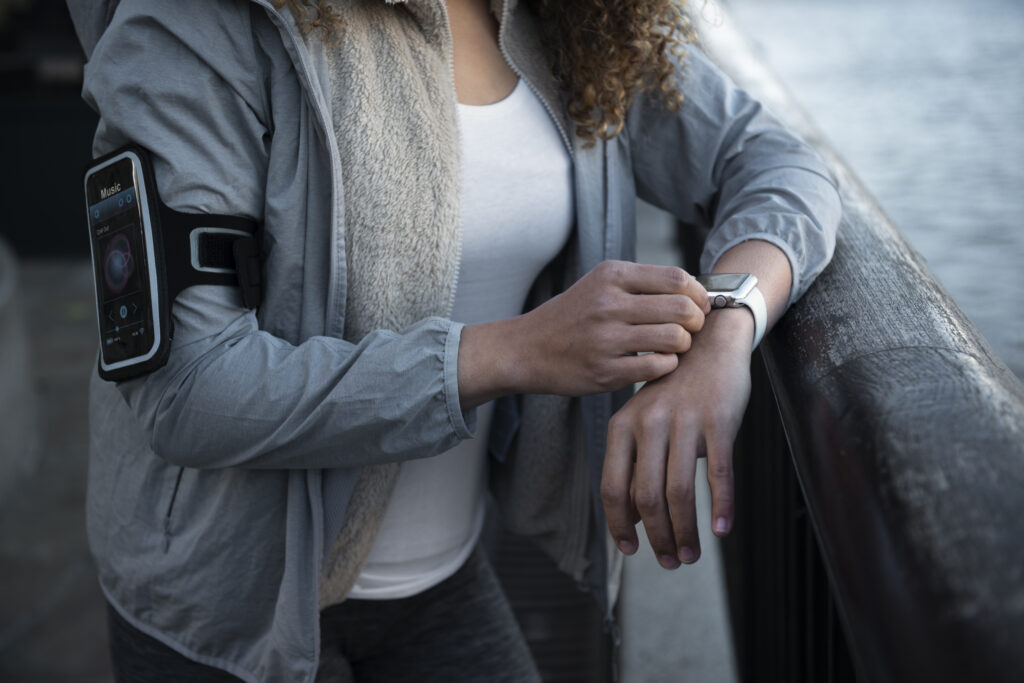Smart rings are the emerging wearable technology that you’ve probably been hearing about. They do all this from a tiny haka worn on your finger!
In the United States, health care workers and technology enthusiasts alike are jumping on these devices. Consumers are demanding more real-time health data without the burden of cumbersome equipment.
Most smart rings are compatible with the latest iPhones and Android devices as well as widely used health applications. Whether you’re in health care or tech, smart rings provide quick and convenient access to important health indicators.
What Are Smart Rings?
Smart rings are compact, low-profile devices that collect health and fitness information straight from your finger. These rings employ state-of-the-art sensor technology to track meaningful metrics while fitting seamlessly into everyday life. Their small form factor is created with tough materials such as titanium or stainless steel.
This design provides maximum comfort and style while delivering serious functionality. Wearable technology in general is getting smaller and much more intelligent. Today, smart rings provide the most unobtrusive method for monitoring health—surpassing wrist-worn devices in efficacy.
1. Defining This Tiny Tech Trend
Smart rings are the latest generation of wearable tech, unique in their compactness and multifaceted capabilities. Unlike their bulkier smartwatch counterparts, they’re much more versatile, fitting seamlessly into nearly any lifestyle and appearing inconspicuous like any other piece of jewelry.
Most models are available in a range of sizes from 6 to 14, with alternative colors to suit personal taste. They aren’t just flashy accessories! This ability to track sleep, heart rate, and movement has made these devices increasingly popular with health-conscious users seeking to collect data without making a public statement.
2. The Magic Inside: Miniaturized Sensors
The magic inside—miniaturized sensors. Tiny sensors are the stars of the show inside each ring. These biosensors monitor your heart rate, body temperature, steps, and more, sending all of this information directly to your smartphone.
Recent advancements allow for these sensors to operate with astonishing precision, all while remaining compact. You access objective health information. This is important for users in clinical settings or for anyone who appreciates accurate metrics.
3. How Finger Wearables Function Daily
During day-to-day use, smart rings discreetly monitor your movements and rest. They sync to your smartphone, allowing you to check your data at any time. Other rings can go 7 to 10 days on a single charge, which outlasts the majority of watches.
Most users report that rings are less distracting and a much more natural fit as a wearable than other trackers.
4. Connecting Seamlessly: Apps and Syncing
Seamless connectivity and integration with apps and syncing. Smart rings pair with companion apps for quick data analysis. These applications typically connect with systems such as Apple Health, allowing users to view patterns and information instantly.
Health data management is easy, and syncing is typically fast and seamless.
5. Why a Ring Over a Watch?
Rings are more discreet than a watch that can buzz on your wrist with every notification. They’re much more discreet and better-fitting for all-day wear, with plenty of users reporting rings are more comfortable for sleep tracking.
As discreet fashion accessories, they seamlessly integrate into any lifestyle without drawing attention to themselves.
My Take: Why Consider a Smart Ring?

Smart rings have particularly intrigued me for how they align perfectly with the trend towards simpler, less intrusive wearables. If you’re serious about tracking your health and fitness, you should definitely get a smart ring. Smart rings deliver all the benefits without the bulk or bling of a smartwatch!
They attract people who are particular about aesthetics, precision, and wearability. Many smart rings last up to ten days between charges and pack in health tracking that rivals most wrist-worn devices. Whether it’s sleep scores, resting heart rate trends, or other health data, the information they present is straightforward and impactful.
You’ll never be inundated with data you don’t need to see. In my experience, most people welcome light nudging. They enjoy easily digestible overviews—particularly when it’s as easy as building better sleep habits or monitoring changes over time. Smart rings are not for everyone. They are not always able to provide the comprehensive data that athletes or serious fitness enthusiasts are looking for with sports watches.
For a significant number of people, they provide the exact combination of utility and aesthetics.
Ditching the Distracting Screen
Smart rings allow you to get away from the 24/7 attention-seeking device that is a phone. By ditching the distracting screen, you’ll be able to glance at notifications or monitor your health metrics without taking your eyes off the road or your environment.
This makes it easy to stay in touch without the screen stress. It is a huge boon for clinicians and managers looking to reduce digital distractions during the workday.
Comfort You Barely Notice
When a smart ring is as thin and light as most models, comfort becomes a non-issue. These rings are light and comfortable. They’re snug but not tight, and you quickly forget you’re wearing them—unlike the bulkier smartwatches.
That comfort results in more consistent use, which in turn drives better health data over time.
Focused Health Insights, Less Noise
Smart rings cut the noise and provide just the health insights you want to focus on. Sleep, steps, heart rate—they simplify it and make it approachable.
For frazzled healthcare pros balancing a hectic work life with a chaotic home life, that simplicity means you can stay on top of your health without added hassle.
Making a Subtle Tech Statement
These smart rings are perfect for people who enjoy the benefits of technology without the aesthetic. They match with your personal aesthetic, no matter if you’re in scrubs, a suit, or denim.
It’s an understated, personal statement that says you value health and design.
Core Smart Ring Capabilities
Read on to learn how smart rings have evolved from simple trackers into powerful tools. Today, they are an indispensable part of the dynamic workflows of both health tech and clinical specialists.
Their sleek design and 24/7 wearability makes it easy for users to monitor health metrics without the hassle or heft. These sensors are meant to track unique biometrics and activities. They deliver continuous insights and typically last 10+ days on a charge.
This allows users to track their health more confidently, without the fear of having to constantly recharge.
Tracking Your Sleep Patterns
How smart rings measure your sleep Smart rings analyze your movement, heart rate, and skin temperature to monitor sleep. This offers an unobstructed look into sleep cycles.
Other rings even have the ability to differentiate deep sleep from REM sleep with an accuracy of 79%! This information allows users to identify patterns and improve their sleep health.
Sleep tracking is important to anyone wanting to improve energy, mood, and daytime productivity. The ring’s feedback on sleep stages and sleep efficiency aids in identifying what improves and hinders sleep.
Monitoring Daily Activity Levels
Smart rings are able to measure steps, monitor movement and record calories burned. These figures will help fitness enthusiasts and active professionals establish targets and monitor their results.
The ring’s minimalist aesthetic allows it to easily fit into a workday, trip to the gym, or walk around the neighborhood. Viewing daily statistics increases motivation and keeps users engaged with healthy behavior long term.
Keeping Tabs on Health Metrics
Smart rings do much more than monitor your steps and sleep. They do this while tracking heart rate, blood oxygen and even monitoring sleep apnea with a 90.7% accuracy.
Being able to track these numbers allows users to prevent problems from developing, manage ongoing care needs, and customize health plans. Insights remain high-level, so users don’t overwhelm themselves with information overload.
Contactless Payments on Your Finger
Other rings simply allow wearers to buy their coffee or groceries with a tap. With the tech utilizing encrypted chips and two-factor authentication to protect data, payments are safer, more controlled, and hassle-free.
This speeds things up and leaves wallets at home.
Simple Notification Alerts
It’s easy to assume smart rings just buzz or light up for incoming calls, texts, and calendar reminders. Users determine which alerts are allowed through, so they’re kept in the loop without overwhelming noise.
That’s how you gain more control over your work, health, and leisure time—without being glued to a smartphone.
Design, Fit, and Feel Matters
Design is perhaps the most important aspect of any smart ring. For the on-the-go professional, style and discretion is as important as the technical capabilities. From a distance, most smart rings tend to blend together, featuring slick lines and minimalist aesthetics.
The small details—such as having an open-gap design—can be impactful. Open gaps allow the ring to flex for chubby or skinny fingers, providing a snug fit that feels natural all day long. Some rings employ a more robust construction, while others go for a shapely, svelte profile.
Because many of these rings are only 2.4 to 3.6 grams, they hardly register on your hand.
Materials Used in Smart Rings
Stainless steel, titanium, and ceramic are popular materials. While stainless steel is extremely durable and traditional in design, it does tend to scratch.
While titanium is more expensive, it is lighter and does not dent. Ceramic is unlike anything we’ve ever felt, ultra-dense and incredibly scratch-proof, though it can chip if dropped.
Skin sensitivity matters—those with metal allergies usually opt for ceramic or hypoallergenic coatings. Available in matte, glossy, and brushed finishes allow users to customize to their unique design aesthetic.
Finding Your Perfect Ring Size
This is why it’s very important to get the right size. Too tight and it pinches finger, too loose and sensors are not in constant contact.
Many brands have ring sizing kits and/or online guides. To avoid this, measure in the evening when the fingers are most swollen.
If your job or leisure activities make your hands expand, opt for an open-band or adjustable style.
Everyday Wearability and Comfort
Smart rings should be ready for everyday life. Design details, such as rounded edges, smooth interiors, and low-profile sensor domes minimize snags and pressure points.
Clearly, people are wearing them everyday—from work to workouts. Lightweight builds and premium materials go a long way towards making them devices you can forget on your hand.
Balancing Tech with Aesthetics
Smart rings should be unobtrusive and cool. A ring that appears to be jewelry, rather than a tech device, is more likely to be worn every day.
Design decisions have been just as wide, from simple fabric bands, all the way to flashy looks. Aesthetic appeal goes a long way in increasing acceptance, so pick the one that works best for your personal aesthetic.
Your Data: Privacy Concerns Addressed
Smart rings, particularly the innovative smart ring models, are uniquely positioned inside the health tech ecosystem today. These fitness trackers unobtrusively and continuously monitor heart rate, sleep, and more, catering to high-performance professionals and clinicians. With this progress comes legitimate concern about how sensitive information is transferred and utilized, especially in light of the smart ring pioneer advancements in technology.
We know that data breaches are a regular occurrence, particularly with the rise of IoT attacks, which doubled in 2020. This underscores the need for more robust measures to protect data, as privacy risks arise from poor data linkages and third-party access to information. The importance of a reliable health tracker cannot be overstated.
A good habit is to question creators on how they protect your data, how much they sell it, and what you can do about it to ensure your wellness tracker remains secure and effective.
Understanding Data Collection Practices
Smart rings track steps, heart rate, skin temperature, and sleep patterns using sensors housed in the small form factor. They upload this data to third-party apps or cloud servers for further analysis. This can be an invaluable tool to assist users in identifying trends or establishing fitness objectives.
All rings collect information such as movement, sleep patterns, and in some cases, location. For one, makers must receive your explicit consent to gather and use this data. Those lengthy privacy policies actually detail where your data is sent, who gets to view it and why.
Reading them helps you spot if your info might end up with another company or used for things you didn’t plan on.
Securing Your Personal Information
Everyday changes can significantly reduce your risk. Don’t forget to enable strong passwords and two-step verification on the app. Avoid unsecured connections.
Stick to secure Wi-Fi networks when syncing your ring. Encryption, a method that transforms data into code, can further protect information when it’s transferred from a ring to a phone or cloud. Some developers today are using cutting-edge solutions such as quantum cryptography to harden data.
Don’t forget the basics—make sure you’re regularly updating apps and reviewing privacy settings.
My Tips for Managing Ring Privacy
TIP #1 Return to privacy settings and lock them down. Don’t share data with anyone you don’t trust with your personal data. Choose anonymous or minimal data-sharing modes whenever possible.
Look out for announcements of new features or improvements from your ring’s manufacturer! They’ll key up their bug fix whack-a-mole game and roll out new advanced privacy features.
Powering These Miniature Gadgets
Smart rings have a reputation for packing a considerable amount of technology into a compact design. How they manage power is one of the more interesting aspects that contribute to their utility. Users of the ring want it to last all day, sometimes multiple days, without having to halt the experience to charge.
Advanced battery design goes into making sure that this battery is built to last. It allows the ring to have a light and lightweight, easy-to-wear form factor.
Smart Ring Battery Expectations
Currently, the majority of smart rings on the U.S. Market achieve a battery life of three to ten days on a full charge. Models such as Oura and Circular, just to name two, are able to continue operating for up to a week on one charge. This is a huge benefit to anyone interested in monitoring their sleep.
They’re able to accomplish this without needing to remove the ring each night! Battery life is highly impacted by increased sensor usage, Bluetooth always on, and additional features. Rings that monitor heart rate or blood oxygen continuously will require additional energy.
Energy impacts of notification brightness and even the size of the smart ring can affect battery life. Before you pull the trigger on a purchase, carefully consider the battery specs. Think about what you’re going to value most—battery life or added functions!
Convenient Charging Solutions
Charging these smart rings is becoming more convenient. Most brand models utilize wireless charging, which means you simply place the ring on top of a charging pad or dock. Some even come with portable charging cases, allowing you to charge them on-the-go.
This is great news for all the busy professionals out there who don’t want to think about how to keep their ring charged. Quick-charge features are becoming ubiquitous, too, so even a brief layover can leave you significantly recharged.
Convenient charging solutions make it easy to pop on a fresh replacement battery, minimizing the downtime each day.
What’s Next for Finger Wearables?
In the US, smart rings are moving beyond novelty and into mainstream everyday use. All in all, the next wave of these wearables looks very promising indeed! It’s fueled by genuine advancements in sensor technology, design, and their convergence with other devices.
These trends are not merely the province of the early adopter technology enthusiast. Healthcare professionals, busy managers, and tech-savvy consumers have all adopted smart rings. They see these devices as the ideal disruptive devices that fit into both their work and home life. Here are the key trends that will be most impactful to this cohort.
The Evolution of Miniaturized Sensors
Sensors get smaller. While sensor technology continues to miniaturize, the quality of data collected improves. Smart rings today have sensors designed with nanotechnology that allow them to detect heart rate, oxygen levels, and sleep cycles.
They even monitor microscopic aspects, such as nuanced body movements and sleep respiratory patterns overnight. This allows users to identify changes before it develops into an issue. Further down the road, an even greater density of sensors will be able to pack into smaller, lighter rings—all made possible by titanium and intelligent design.
Even as the sensors shrink, what they can do expands, so rings can monitor a variety of things without an oversized look and feel.
Potential for Gesture Recognition
Tangible gesture control is on the verge of becoming the norm. That means consumers will be able to swipe a finger or tap a ring to initiate a phone call! They can, too, advance a slide deck or dim the lights.
For physicians, or anyone whose hands need to be sterile, this technology allows them to stop touching screens. The gesture recognition field is wide open for rings to learn additional gestures. This new technology simplifies everyday life and reduces cognitive load!
Smarter Integration with Other Tech
Whether they’re smart rings like the Oura Ring or otherwise, rings are beginning to communicate with other devices. They can unlock doors, pay for your morning cup of joe, or pair with smart home devices.
This has been made possible due to rings being able to integrate with multiple other systems and not just mobile phones. The smarter they’re integrated with other tech, the more helpful they are. This is true whether in a clinic, office, or at home.
Future Health Monitoring Potential
Smart rings are moving into health in a major way. With longer battery life—some last up to 10 days—rings can continuously measure heart health, stress levels, and sleep. This allows clinicians to better identify trends and users to monitor emerging problems in a more timely manner.
The logical next step is to incorporate more health options, like blood pressure. Next to this, we’ll put comfort at the front and center—literally so rings can be on 24/7.
Conclusion
Smart rings have a lot of potential for people looking to combine health and tech in one sleek form factor. These rings monitor your activity, heart health and seamlessly integrate into your lifestyle. Americans are impatient with things that aren’t quick and convenient. With a smart ring, you can get accurate, reliable, real-time health data you can trust— straight from your finger. With real-time updates and reduced click-throughs, doctors and other busy pros have more time on their hands. Goodbye to cumbersome wires and awkward apps. If the market is any indicator, these rings are only going to become smarter and less obtrusive. Looking to reduce employee burnout and reduce time spent at a desk? Try out a smart ring today and discover how it can revolutionize your workflow and enhance your ability to care for others.






